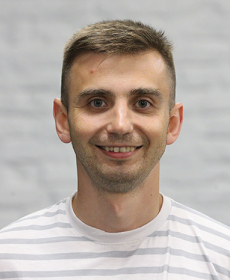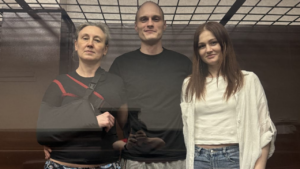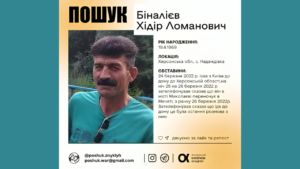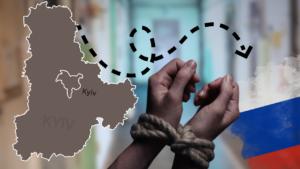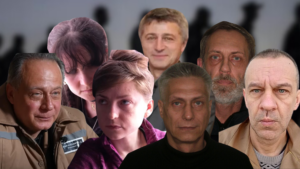Ihor Talalay: three months of “filtration” in torture chambers of occupied Donetsk Region

Appalling conditions of incarceration, harassment, and physical violence are some of the tactics Russians resort to in so-called filtration camps in the occupied territories of Ukraine. Those unlucky enough to end up there call them concentration camps from which few manage to get out.
Ihor Talalay, a 25 y.o. native of Dnipro, was subjected to this “scrutiny” by Russians for three months. They detained him on the way out of Mariupol.
Trip to Mariupol: things didn’t go as planned
In early March, Ihor Talalay was helping people evacuate from Kharkiv. He joined an improvised volunteer convoy in his old jalopy of a car, Lada 2111, in harsh weather alternating between snow and rain. He delivered humanitarian aid from Dnipro and returned with evacuees. Volunteers evacuated more than 400 citizens of Kharkiv in just one week.

Soon the need for evacuation from Kharkiv became less pressing as remaining locals became less willing to leave. So Ihor began looking for other ways he could help. He met volunteers who were helping evacuees from Mariupol and joined them. The first trip was planned for the morning of March 18.
“But things didn’t go as planned from the outset,” says Ihor, adding: “We set out late: not at five a.m. as we intended to, but after seven a.m. because the coordinator overslept. My engine started to misfire between Dnipro and Zaporizhia. It ‘fixed itself’ in Zaporizhia. There I joined the convoy, which wasn’t too organized, and this made me uneasy.”
Still, the young man did not mind the complications en route: there were people waiting in Mariupol, hoping to evacuate that day.
Ihor says that sensed real fear upon seeing the first letter “Z” on military vehicles.
Later that evening the volunteers arrived in Manhush—a village on the outskirts of Mariupol—and found shelter among refugees from the city (mostly women with toddlers). They invited the volunteers to spend the night. But Ihor felt uncomfortable asking these people for help at a time when they were in need of assistance themselves.
The young man spent the night in his car. He also turned down the food offered by the refugees. He decided that he could skip meals for a day without too much trouble.
At 5 a.m., Ihor recorded a video for his Instagram page. He told about the start of evacuation of Mariupol citizens. The convoy then got underway.
Talalay had addresses of people waiting to get evacuated. They were an elderly woman with her son, a young couple (a young man and his girlfriend), and a family with children. All of them would not fit into his car, so Ihor planned to take the first four to Manhush before returning to get the family.
Yet he never made it to Manhush. There was a roadblock in the middle of the road outside the village of Chervone. According to Ihor, it was manned by DNR militias. One of them ordered him to exit the car and pop the trunk open.
“I was wearing Ugg boots, and he didn’t like them. He asked: ‘What kind of slippers are you wearing? And what kind of socks?’ He suspected that I was with the army and was trying to escape disguised as a civilian,” Ihor says.

Apart from the “suspicious” footwear and socks, Ihor’s “military image” was enhanced by his tired bloodshot eyes and several patriotic photos on his phone. One of them showed the flag of Ukraine.
Ihor was taken to a garage for questioning and was forced to strip down. He had a red vascular pattern on his shoulder from sleeping in the car the night before. The Russians thought it was a mark left by the butt stock of an automatic rifle. They were also irritated by Ihor’s overly calm composure.
“They threatened with with a pistol. One of them said: ‘I will now shoot you through your knee and you will bleed to death behind the garages’. I realized that this could be part of their scare tactics, but I wasn’t 100% certain,” Ihor recalls.
The young man named almost every car in his volunteer convoy along with number plates. He tried to prove that he was not with the army but merely a volunteer, but to no avail. Ihor was thrown into the basement.

He shared it with two conscripts and one civilian. Five hours later they were taken to Manhush.
Detention in Manhush: they said they would release me in 20 years
The detainees were kept outside the district police headquarters almost all day long. Ihor was out of luck: he was almost at the end of the queue. Once inside, he was asked standard questions about his identity and occupation, then beaten and subjected to moral pressure. “They said: ‘That’s it, you are up for filtration. You will be released in about 20 years’. I kept silent,” Ihor says.
Talalay ended up in a district precinct cell measuring three by three meters, which is called a “monkey cage” in police jargon. It is big enough for 5-6 people, but they kept 32 there. They were guarded by Ukrainian traitor cops who switched over to the Russian side.
Men were kept in cells, while women were sitting on the floor in corridors. The oldest detainee was 66, and the youngest one 18.
It was March 20, 2022. Ihor had no food for five days and only drank water.

Operation “Filtration”. The ordeals of Ukrainians under Russian occupation
The following morning the detainees were transported to the town of Dokuchaevsk. There they spent the entire day outdoors with their hands taped together. Their hands were freezing because they could not hide them.
“There was a tall white wall in the courtyard. We were standing next to it. I began thinking: Would they shoot us dead? Then I thought: no, that’s unlikely,” Ihor recalls.
Everybody was then put in cells. Ihor’s cell was just as small as the one in Manhush. But this one held 15 people and not 32.
“We could lie down,” Ihor says, adding: “In the evening they gave us each a slice of bread. And then they gave us a bowl of soup… one for all. And one spoon, accordingly.”
Sometime later Ihor came up with the idea to ask the guards to buy them food with the money the detainees had. The guards agreed and talked a local employee of the “police precinct” named Inna into buying them food. They converted hryvnias to roubles one to one, and after a while the detainees took delivery of five packs of sausages, two loaves of bread, and five chocolate bars.
Interrogation: they held him by the neck and lifted him up
The following day the detainees were transported to the local UBOZ (organized crime control headquarters) in Donetsk. The treatment there was harsh.
“They treated us as if we were some sort of cutthroats who arrived to serve a life sentence. Those from Azov or Right Sector were treated even more cruelly,” Ihor explains.
A cell measuring 3.5 by 3.5 meters held 25 people. The cell was dark and fetid, without any ventilation. There was no toilet either, only a bottle.
Detained border guards from Mariupol were taken from Ihor’s cell. They were beaten mercilessly and then brought back. Ihor himself had the same experience later.

“Our talk did not work out. They tied my hands and started chocking me. One of them held me by the neck and lifted me up, saying: ‘Does it hurt?’ And I could not even breathe. I barely managed to say: ‘It hurts’. He released me. Then I was on the receiving end of a cruel beating with a butt stock of an automatic rifle,” Ihor recalls.
Other interrogations happened like this: the young man was summoned, an UBOZ investigator was at the table going through his phone, while Ihor was sitting quietly.
In all likelihood, the evacuation videos recorded by Ihor helped him avoid a harsher fate at the filtration camp.
Once they came for him at night. They forced to sign him a waiver of an attorney. The following morning they had him take a lung X-ray before moving him to a prison camp in Olenivka, Volnovakha District.
Move to the prison camp: anthem of Ukraine
In Olenivka, Ihor found himself in a harsh pro-Russian environment. Some of the inmates there were supporters of the “Russian world”. They pressured the new arrivals with musings about “a good Russia”.
“I didn’t know how propaganda works and I feared they would make me roll over. Inwardly I was singing the anthem of Ukraine to zone out those people around me. And in the morning I woke up with the words ‘Glory to Ukraine!’ This gave me confidence that I would be immune to propaganda,” Ihor says.
The disciplinary facility known as DIZO, where they put Ihor in Olenivka upon his arrival, is a dark two-story unheated building where people are kept without water and no means of maintaining hygiene.
There were 28 people in the cell. They slept on mattresses scattered on the floor. There weren’t enough mattresses for everybody. Some people were resting on the bench next to the table, while others on the table itself.
There were three meals a day, but one helping was small enough to fit in a palm. Sometimes they would “forget” to feed the inmates.
Ihor was taken to the barracks after a few days at the DIZO facility. It was also a two-story building but with its own grounds where inmates could walk freely. The guards were only watching from across the fence.
Each barracks building had its own leaders who communicated with the prison camp leadership. There were 150 people in the first barracks building where Ihor was kept.
“Inmates slept on wooden boards placed on the ground,” Ihor recalls, adding: “Sleeping on two boards was more or less fine. It was altogether ideal on three boards. But there weren’t enough boards for everybody. Usually there were two boards per three inmates. We all slept as a group. When somebody turned over, all the others turned over. The building itself was old and moist. It smelled accordingly.”
Life in the barracks happened according to schedule. Everybody lined up at 6 a.m. and guards did a head count. Sometimes they would do a roll call by name. Breakfast was at 11 a.m. Four inmates walked around with a large cauldron and portioned out gruel. For 150 people in the barracks building, there were 30 plates and about 15 spoons.
“The sensation of hunger was constant there, even after you ate. I would stand there hungry waiting for my turn to eat only to feel hunger again,” Ihor Talalay says.
He spent almost an entire month in Olenivka, from March 23 to April 20.
To be clear, this was not even a penalty, but mere “administrative detention”. In the so-called “DNR”, people get detained for 10 to 60 days even if they did not commit any offense. A person then gets released unless they fabricate a case against them.
Two months of checks: talks with fellow inmates
The people in Olenivka with whom Ihor communicated struck him with the polarity of their approaches to the situation they found themselves in.
One of the hostages with whom Igor made friends was a soldier who fought near the Airport of Donetsk in 2016. When the full-scale invasion began, the man rejoined the ranks but was taken captive in Mariupol. Once in captivity, he was tortured with electricity: his hands or feet were doused in water and had wires connected to them through which current coursed.
“He was laying right across from me and woke up every morning with a smile on his face. And I wanted to talk to him because he charged me with positivity,” Ihor Talalay recalls.
He also supported others himself. One of the guys was a territorial defense fighter who was sinking into a depression. Ihor helped him keep a positive mindset, for which the man repaid him: after his release he called Ihor’s mother to let her know where her son was.
“There was also Mykola Mykolayovych. He owned a logistics company and was a big name among locals. When the war broke out, he sent his family to a safe location and transported people from the left bank of Mariupol to the downtown area where they could evacuate,” Ihor continues, adding: “The inscription on the door of his car read: ‘Your best day’. Old ladies would break out in tears when they got into the car through this door.”
Mykola Mykolayovych found himself in captivity because he rammed a Russian armored personnel carrier: he was driving on a highway and a car in the oncoming lane blinded him, causing him to run into the Russian military transport parked on the road shoulder.
The volunteers who inadvertently blinded Mykola Mykolayovych shared the same cell with him because they were also subjected to ‘administrative detention’.
In Olenivka, people were often transferred from one barracks building to the next. Ihor got lucky with the last barracks building: it had soap and water. He was able to wash himself and wash his clothes for the first time since getting detained. But they came for him shortly afterwards. They took him to a pretrial detention facility where he had to sign an extended administrative arrest report or what the young man refers to as “resigning a contract for a resort stay.”
This was followed by two days at the pretrial detention facility during which the report was never signed. He was then briefly returned to the overcrowded prison camp in Olenivka: there were almost 3,000 inmates even though the camp was big enough for 1,700.
“I ended up at the DIZO disciplinary facility once again. There were 48 people in a cell big enough for 6. We had to sit while having the knees pressed against the chest: this was all the space you had. The toilet there had two walls on either side: one person was sitting on one wall and two more on the other wall,” Ihor Talalay says.
After another day in such conditions he was returned to the more comfortable pretrial detention facility. He did not leave it anymore and stayed there from April 20 to June 14.
On the way to release: with a certificate proving “filtration”
In almost two months that Ihor spent among four walls with frosted glass windows, he learned to tell the time by the way the light cast shadows. He and his fellow inmate at the pretrial detention facility—a colonel—fashioned a makeshift game of backgammon from bread. That’s how they passed the time in captivity.
Ihor describes the moment of his release ironically: “I was at my usual location having a great time playing backgammon until they came and called my name.”
The young man was rushed outside the fence without any belongings or even a certificate proving his release. They told him to go to the UBOZ organized crime control headquarters. Ihor reached it only in the evening. Since no management was around, Ihor got locked up in a cell again.
In the morning he received a stamped certificate proving his filtration valid for an indeterminate period. With this certificate Ihor first made it to Volnovakha and then to occupied Berdyansk. He was not in a hurry to leave the town. He says that something was keeping him from leaving.
There Ihor found some local volunteers and stayed with them for a while. It was until he received a cry for help from a young lady from Lviv, who was looking for a hostage in the so-called “DNR”. He tracked the man down. It turned out that the man—just like Ihor a few days ago—was left with nothing after grueling captivity. The young man was eventually transported to Ukraine-controlled territory.
Ihor himself returned home shortly afterwards.

“All this time I kept telling all those around me—and believed it myself—that I would return and that everything would be alright,” Ihor Talalay says, adding: “I did not fall into despair because of this dead-end situation and thought: if this does not drag out for tens of years but ends at least this year, this has been quite an adventure. I was important for me to keep a positive mindset and inspire others. This gave me strength to survive the toughest moments of captivity.”


